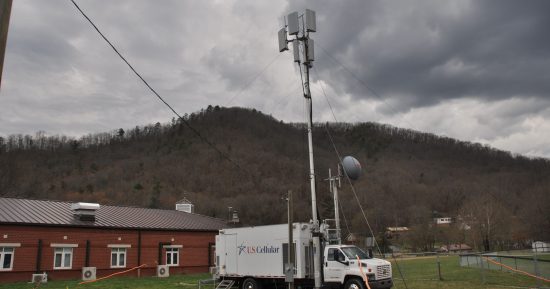To help slow the spread of the coronavirus, the GMU campus is moving to remote instruction and Mercatus is moving to remote work for employees until the risk subsides. GMU and Mercatus employees join thousands of other universities and businesses this week. Millions of people will be working from home and it will be a major test of American broadband and cellular networks.
There will likely be a loss of productivity nationwide–some things just can’t be done well remotely. But hopefully broadband access is not a major issue. What is the state of US networks? How many people lack the ability to do remote work and remote homework?
The FCC and Pew research keep pretty good track of broadband buildout and adoption. There are many bright spots but some areas of concern as well.
Who lacks service?
The top question: How many people want broadband but lack adequate service or have no service?
The good news is that around 94% of Americans have access to 25 Mbps landline broadband. (Millions more have access if you include broadband from cellular and WISP providers.) It’s not much consolation to rural customers and remote workers who have limited or no options, but these are good numbers.
According to Pew’s 2019 report, about 2% of Americans cite inadequate or no options as the main reason they don’t have broadband. What is concerning is that this 2% number hasn’t budged in years. In 2015, about the same number of Americans cited inadequate or no options as the main reason they didn’t have home broadband. This resembles what I’ve called “the 2% problem“–about 2% of the most rural American households are extremely costly to serve with landline broadband. Satellite, cellular, or WISP service will likely be the best option.
Mobile broadband trends
Mobile broadband is increasingly an option for home broadband. About 24% of Americans with home Internet are mobile only, according to Pew, up from ~16% in 2015.
The ubiquity of high-speed mobile broadband has been the big story in recent years. Per FCC data, from 2009 to 2017 (the most recent year we have data), the average number of new mobile connections increased about 30 million annually. In Dec. 2017 (the most recent data), there were about 313 million mobile subscriptions.
Coverage is very good in the US. OpenSignal uses crowdsourced data and software to determine how frequently users’ phones have a 4G LTE network available (a proxy for coverage and network quality) around the world. The US ranked fourth the world (86%) in 2017, beating out every European country, save Norway.
There was also a big improvement was in mobile speeds. In 2009, a 3G world, almost all connections were below 3 Mbps. In 2017, a world of 4G LTE, almost all connections were above 3 Mbps.
Landline broadband trends
Landline broadband also increased significantly. From 2009 to 2017, there were about 3.5 million new connections per year, about 108 million connections in 2017. In Dec. 2009, about half of landline connections were below 3 Mbps.
There were some notable jumps in high-speed and rural broadband deployment. There was a big jump in fiber-to-the-premises (FTTP) connections, like FiOS and Google Fiber. From 2012 to 2017, the number of FTTP connections more than doubled, to 12.6 million. Relatedly, sub-25 Mbps connections have been falling rapidly while 100 Mbps+ connections have been shooting up. In 2017, there were more connections with 100 Mbps+ (39 million) than there were connections below 25 Mbps (29 million).
In the most recent 5 years for which we have data, the number of rural subscribers (not households) with 25 Mbps increased 18 million (from 29 million to 47 million).
More Work
We only have good data for the first year of the Trump FCC, so it’s hard to evaluate but signs are promising. One of Chairman Pai’s first actions was creating an advisory committee to advise the FCC on broadband deployment (I’m a member). Anecdotally, it’s been fruitful to regularly have industry, academics, advocates, and local officials in the same room to discuss consensus policies. The FCC has acted on many of those.
The rollback of common carrier regulations for the Internet, the pro-5G deployment initiatives, and limiting unreasonable local fees for cellular equipment have all helped increase deployment and service quality.
An effective communications regulator largely stays of the way and removes hindrances to private sector investment. But the FCC does manage some broadband subsidy programs. The Trump FCC has made some improvements to the $4.5 billion annual rural broadband programs. The 17 or so rural broadband subprograms have metastasized over the years, making for a kludgey and expensive subsidy system.
The recent RDOF reforms are a big improvement since they fund a reverse auction program to shift money away from the wasteful legacy subsidy programs. Increasingly, rural households get broadband from WISP, satellite, and rural cable companies–the RDOF reforms recognize that reality.
Hopefully one day reforms will go even further and fund broadband vouchers. It’s been longstanding FCC policy to fund rural broadband providers (typically phone companies serving rural areas) rather than subsidizing rural households. The FCC should consider a voucher model for rural broadband, $5 or $10 or $40 per household per month, depending on the geography. Essentially the FCC should do for rural households what the FCC does for low-income households–provide a monthly subsidy to make broadband costs more affordable.
Many of these good deployment trends began in the Obama years but the Trump FCC has made it a national priority to improve broadband deployment and services. It appears to be be working. With the coronavirus and a huge increase in remote work, US networks will be put to a unique test.



 The Technology Liberation Front is the tech policy blog dedicated to keeping politicians' hands off the 'net and everything else related to technology.
The Technology Liberation Front is the tech policy blog dedicated to keeping politicians' hands off the 'net and everything else related to technology.